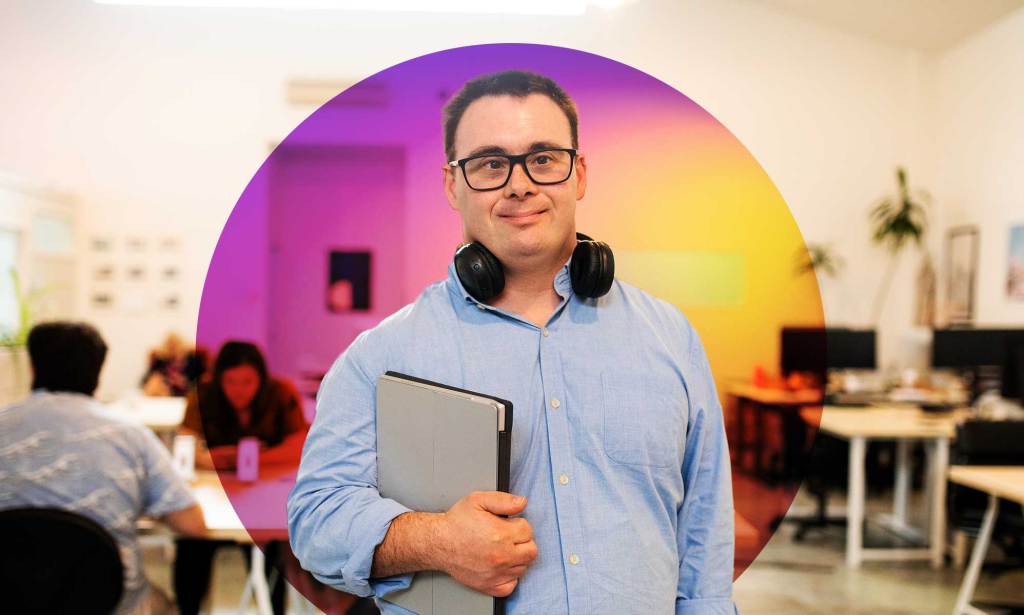How can businesses support disabled employees?

One in five working adults are living with a disability in the UK, we share tips on how businesses can support their disabled employees. (Getty Images/PinkNews)
As Disability Pride Month ends, now is the time to remind businesses that supporting their disabled employees is part of a year-round commitment to fostering an inclusive and diverse workplace.
In the UK, 22 per cent of the population live with a disability, and data from the government highlights the inequities that confront the disabled community. Disabled people in the UK are 25 per cent less likely to have a degree and more likely to have no qualifications. When it comes to home ownership, the disabled community are less likely to own their own home and more likely to be living in a housing scheme.
When it comes to employment, there are nearly five million disabled people holding a job in the UK – one in five of the working population age. The disability employment rate was at nearly 53 per cent in 2022, compared to 83 per cent for non-disabled people.
It’s important to note that the pandemic impacted the disabled community more than other marginalised groups. Aside from the higher mortality and hospitalisation rate, many disabled people haven’t returned to work since the pandemic started.

The business case for supporting disabled employees
Over time, the number of people reporting a long-term health condition or disability will continue to rise. This is due in part to an ageing population and more people being diagnosed with mental health conditions.
As this marginalised community grows, it makes sense for businesses to have support in place, like they would for other under-represented groups. There are so many data points that reflect the benefits of having a diverse workforce, specifically, Forbes revealed that diverse teams deliver 60 per cent better results and make better decisions.
Joseph Williams, co-founder and CEO of skills-based hiring platform Clu and the co-founder of the LGBTQ+ disability charity ParaPride, believes that inclusion for the disabled community can drive social mobility, economic growth and workplace equity.
“They [the disabled community] are a hugely under-tapped but highly skilled, segment of working-age adults,” he tells PinkNews.
“Systems and processes just prevent them from being able to deploy those skills in a safe and accessible way.”
Williams highlights the potential for innovation and new products and services that the disabled community can bring into a business.
“They are used to coming up with creative solutions and overcoming hurdles in their personal life.”

How businesses can support disabled colleagues
Empowering disabled colleagues to thrive in the workplace not only contributes to a more equitable society but also unlocks a wealth of unique perspectives, talents, and innovative problem-solving.
Here are a handful of ways businesses can truly ensure that their workplace is inclusive for the disabled community that go further than boasting an “inclusive environment” in job adverts.
Acknowledge that not all disabilities are visible
Of the disabled people in the UK, 80 per cent live with a disability that isn’t visible. There are many conditions that aren’t obvious and make life demanding for many people. Hidden disabilities include a wide range of physical and mental conditions like blindness, depression, colitis, and chronic fatigue syndrome as well as neurodivergent conditions like ADHD and autism.
To truly understand their disabled employees, management teams need to acknowledge that many will be living with these hidden disabilities and also that not everyone has the same experience with their own disability.
Make sure every part of the recruitment process is accessible
A stock image of a disabled person working in recruiting content is a nice gesture, but if the process to even apply for the job isn’t accessible then it means nothing.
Aside from stating that adapting the interview process to meet individual needs in the job description, recruiting teams should consider the first step in the process and offer up applications and other documents that are accessible including documents that are in large print, braille, or compatible with screen readers.
Job descriptions should only focus on the essential skills and experience that are required for the role. Including preferred criteria, such as specific educational backgrounds or physical attributes, can inadvertently discriminate against candidates with disabilities.
Pay disabled employees equally
This may seem like a no-brainer, yet in the UK the disability pay gap is larger than the gender pay gap.
Analysis from Trades Union Congress (TUC) found that non-disabled people earn 17.2 per cent more than disabled colleagues. Based on a 35-hour work week, that is £3,731 annually.
It goes without saying to treat all employees fairly and pay employees with disabilities equally. Aside from the moral case, an employer with an inclusive employee brand will attract talent and create a much more positive workplace culture.
As a starting point, employers should include the pay band range in the job posting for full transparency.

Offer to modify working arrangements
Aside from the incoming legal requirement, employers that offer flexible working options benefit all employees, especially the disabled community. Focusing on the work and not the time the work is done gives the community the flexibility to attend appointments and focus on their medical care if it is needed.
Besides the gift of time, employers can also support their disabled employees by ensuring that they have everything they need to do their job effectively. Things like noise-cancelling headphones and quiet spaces for neurodivergent employees and screen readers for visually impaired employees will boost employee productivity and engagement.
Offer training and education to all teams
Employees without disabilities may not be aware of the challenges that their colleagues with disabilities face, and the accommodations they may need. Training employees on the difficulties people with disabilities face at work can help them to be more understanding and supportive of their colleagues.
Williams says that getting rid of the unconscious bias will give “the whole company space to be accessible, beyond the disabled employee’s desk.”
Promote inclusive policies
When employers actively listen and put into policy what their employees need to thrive, they promote inclusion and consider employee wellbeing a priority. Employee resource groups (ERGs) provide a platform for employees to share their experiences and work with leadership teams to implement new initiatives based on their input and feedback.
For the disabled community, ERGs can work with operations teams to create a working space where meeting rooms, break-out spaces and toilets are accessible to everyone.
To promote inclusion for all, leadership teams need to lead by example and shout loudly about any new policy that will benefit their employees.
Partner with disability charities
When a business partners with a disability charity or advocacy group it shows a commitment to ensuring those employees are supported. Charities and groups can provide additional training and resources that will help de-stigmatise the workplace.
Williams concludes that consulting with external advocacy groups provides “expertise and support to drive a fully inclusive workplace, supporting the employee on a micro level and senior management and company policies on a macro level.”

